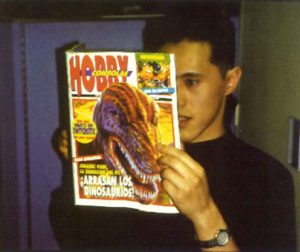This short Interview with Sonic designer Naoto Ōhshima appeared in issue #23 of the Spanish game magazine Hobby Consolas. While it doesn’t share any new information, it does give a bit more perspective into Ohshima’s thoughts on Sonic’s evolution and his role in his rise to stardom.
* * *
 Getting an exclusive interview with Naoto Ōhshima is a really difficult task. But not because you have to travel to Tokyo, get to one of the many buildings that Sega has in the city and contact the right person who leads you to the Consumer Products R&D Department. No. The hardest part of all is getting permission from his bosses to talk to him.
Getting an exclusive interview with Naoto Ōhshima is a really difficult task. But not because you have to travel to Tokyo, get to one of the many buildings that Sega has in the city and contact the right person who leads you to the Consumer Products R&D Department. No. The hardest part of all is getting permission from his bosses to talk to him.
Ōhshima is one of the most coveted graphic artists in the world and those in charge of Sega don’t like that he appears too frequently in magazines… (this competition is always on the lookout). In fact, we weren’t allowed to take any pictures of him and only under the pretext that he leafed through the magazine were we able to get this snapshot in which half of his face can be seen. A true achievement!
Possibly to some of you the name of Naoto Ōhshima will not suggest to you, in principle, too much. But if we tell you that this young Japanese man is the true “father” of Sonic, his designer, and the one who gave him shape and life, you will soon recognize that we are dealing with one of the greatest geniuses in the history of video games.
Hobby Consolas: Where did the idea for Sonic come from?
Naoto Ōhshima: Sega wanted to develop a new game concept, one that would have a new story and be different from anything seen before.
That is why we gathered a group of people who, each one in his area, wanted to do something completely revolutionary. The result was Sonic.
Hobby Consolas: So, Sonic was already created to be the character most representative of Sega?
Naoto Ōhshima: No. From the first moment we realized that Sonic was not going to be just another character, that he was going to be something special, and that’s why we gave him a lot of attention, but we could never even imagine that Sonic would become what he is today.
Hobby Consolas: What came first, the game or the character?
Naoto Ōhshima: The idea of the game came first and then the character came by itself. Obviously, the development of the game lent itself to the protagonist being very fast, but then we added other details that became part of his charisma. For example, something very important to us is his color, blue. In Japan, blue symbolizes many things. It means peace, the ocean… and also the Sega logo is blue.
Hobby Consolas: And why, precisely, a porcupine?
Naoto Ōhshima: For the simple reason that he wasn’t a famous person, and we wanted to do something different…
Hobby Consolas: Currently a group of about 20 people are working on Sonic for Mega CD. How will it be different with respect to his predecessors?
 Naoto Ōhshima: The main differences are found in the new possibilities offered by the Mega CD. The story is also different, but this is all an absolute secret and I can’t talk about it. I can only say that while in Sonic 2 you had to go through different and separate phases, Sonic CD is a complete story from beginning to end. As for the sound, there are also many differences…
Naoto Ōhshima: The main differences are found in the new possibilities offered by the Mega CD. The story is also different, but this is all an absolute secret and I can’t talk about it. I can only say that while in Sonic 2 you had to go through different and separate phases, Sonic CD is a complete story from beginning to end. As for the sound, there are also many differences…
Hobby Consolas: Are you sad because Sonic 3 is being developed in the U.S.A.? Do you feel like your favorite character has been taken from you?
Naoto Ōhshima: I don’t feel like that, in fact most of the programmers that are working on Sonic 3 also worked on Sonic 1, so it’s also theirs. I don’t think it’s a thought that can’t be in the group (a tear spills down his cheek), but what I do want is to do something much more spectacular with Sonic CD than what is being done in the United States.
Hobby Consolas: One last question. Has creating Sonic made you rich?
Naoto Ōhshima: I’m an employee and I work for my company, Sega. I didn’t get rich, but I’ve found something incomparable; I’ve created something the whole world admires, and that can’t be bought with money.

Recent Comments